Four Cloud Trends to Shape Healthcare in 2019
Originally published January 3, 2019 by Matt Ferrari, Co-Founder & Former CTO, ClearDATA at healthcareglobal.com
At the start of 2018, the healthcare industry found itself in the midst of a significant change including the adoption of the public cloud, multi-cloud access, the widespread use of emerging technologies like machine learning and artificial intelligence and planning around increasingly complex regulatory frameworks including the enactment of the General Data Protection Regulation (GDPR) in May 2018. This called for the three major public clouds – Amazon, Google and Microsoft – to consistently bring new solutions to the market (often behind a Business Associate Agreement and meeting HIPAA compliance frameworks) that evolved how healthcare does business.
Properly implemented and maintained, cloud-based solutions offer payers, providers, life sciences and Software as a Service (SaaS) healthcare organisations unprecedented opportunities to innovate and glean insights from massive data sets while still maintaining privacy, security, and compliance.
With advancements in technology and security over the last year, many healthcare organisations can harness the benefits of the cloud now more than ever before. The global healthcare cloud computing market was estimated at $20.2bn in 2017 and is predicted to grow to $35bn by 2022 according to a recent BCC Research report. As we see more development in technologies like telehealth, remote monitoring, and natural language processing APIs, cloud technology will continue to evolve to fit our new digital health landscape in four important ways in the coming year.
- Multi-cloud use will increase in 2019, especially for larger enterprises.
Larger enterprises are seeing distinct advantages of particular clouds, especially for Platform as a Service (PaaS) solutions. Healthcare organisations are gaining confidence that they can effectively partner with more than one cloud provider. Rather than thinking about multi-cloud as separate cloud providers for different applications, disaster recovery, or cloud provider diversity, 2019 will see a focus on a cohesive healthcare multi-cloud strategy around different public cloud services for the same application.
As cloud computing platforms increase their ability to store, secure, process and analyse, we will continue to see healthcare transformed by data. For example, Google has a strong history in big data, analytics, and machine learning, culminating in the launch of their Google Health API. As multi-cloud access increases, we can expect healthcare organisations to use Google Cloud’s expertise while also consuming services such as Amazon Simple Storage Service and Amazon Elastic Compute Cloud for computing and data storage to meet the unique needs of their business.
See also
- Pharmaceutical and life sciences companies will have another big year in cloud adoption.
If you look at the services that are being deployed by Amazon Web Services (AWS), Google Cloud Platform, and Microsoft Azure, a large percentage revolves around making data easier to consume, whether it be new database architectures, de-identification, classification, anonymisation or compliance-led initiatives. All of these services help break down critical barriers for pharmaceutical and life sciences organisations to put their data to work as they progress in analysing large and diverse sources of data, and work to speed their time to market. In 2019, as applications become more mobile and web-based, we will continue to see a strong cloud adoption across pharmaceutical and life science organisations on a global scale.
- The adoption of container and serverless technologies in healthcare will become mainstream.
While they are not new technologies, organisations will reprioritise containers and serverless services (think Kubernetes) as we see significant growth in artificial intelligence and machine learning in healthcare. Adoption of serverless technologies offers organisations a cost-effective way to launch applications without provisioning or managing any servers, further limiting vulnerabilities within the healthcare environment. As cloud computing platforms increase their ability to store, secure, process and analyse, we will continue to see healthcare transformed by data, and the ability to find meaning in it, and share it across silos with increasing interoperability.
- Complexity will increase in 2019, and with multi-cloud, there will be a need for greater attention to security, compliance, and privacy.
The ‘seams’ or boundaries between environments are often the most vulnerable points and multi-cloud, while offering many advantages, can create new security complexities. The complexity itself will continue, shifting from simply understanding Infrastructure as a Service (IaaS) on one cloud provider to strategizing how SaaS and PaaS can work together.
In addition to the technology aspect, the challenges many organisations faced with GDPR compliance in 2018 will continue to bleed into the new year. A GDPR certification framework is still a long way from fruition and the principles of “state of the art” measures to protect data are open to interpretation, much like HIPAA was until HITRUST provided prescriptive guidance. Very few companies fully understand how to architect cloud solutions in a manner that complies with GDPR principles. Now that more healthcare organisations are becoming GDPR aware, we will see these organisations utilise Microsoft in some locations and AWS in others as they seek to leverage the cloud while keeping governance and privacy their highest priority.


